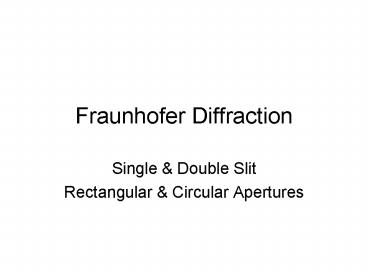Fraunhofer Diffraction - PowerPoint PPT Presentation
1 / 31
Title:
Fraunhofer Diffraction
Description:
ri cannot differ from r0 by more than the distance w ... The Hand waving version: Each contribution to the sum. is a phasor of the same ... – PowerPoint PPT presentation
Number of Views:839
Avg rating:3.0/5.0
Title: Fraunhofer Diffraction
1
Fraunhofer Diffraction
- Single Double Slit
- Rectangular Circular Apertures
2
Huygens construction
Each point on the wavefront is the source of new
Huygen wavelets.
3
Single Slit case in Fraunhofer limit.
Screen point so distant that all rays
are approximately parallel.
4
(No Transcript)
5
The Hand waving version
Each Huygen wavelet contributes to the electric
field at the screen point.
ri cannot differ from r0 by more than the
distance w
6
A
Each contribution to the sum is a phasor of the
same magnitude and frequency. Since the source
points for the wavelets are evenly spaced in y,
the angle between consecutive phasors is constant.
7
The vibration curve it results from adding all
the phasors tip to tail
R
s
So the curve is a circle.
The angle ? is the angle between phasor 0 and
phasor 8
8
R
s
Since
9
Now via integration
10
(No Transcript)
11
Double slit
12
(No Transcript)
13
Rectangular Aperture
In 3-d we will use spherical Huygen wavelets
s
rA
Subscript A for aperture coordinate, S for screen
coordinate
14
(No Transcript)
15
(No Transcript)
16
Neglect this part
How to justify that?
17
(No Transcript)
18
(No Transcript)
19
(No Transcript)
20
ys
xs
21
2a
22
Recast
in polar coordinates
23
(No Transcript)
24
?
25
First root of J1(? ) is at ?3.832
gives location of first minimum
Solves to
26
Rayleighs criterion A telescope is limited by
diffraction, each point of light is imaged as a
bulls eye pattern (Airy disk). If any two
point sources are close together so that their
1st minima overlap, they are said to be
unresolved.
D
27
(No Transcript)
28
Rectangular Aperture
s
rA
29
Arbitrary Aperture
Fourier Transform of Aperture Function
There could be variations of transparency, A does
not need to be constant. There could be
variations of thickness e.g. of emulsion in
hologram. A can be complex!
Computer generated holograms Pattern
recognition,.
Fourier Optics
30
Fast Fourier Transform
Kinoform
31
(No Transcript)































